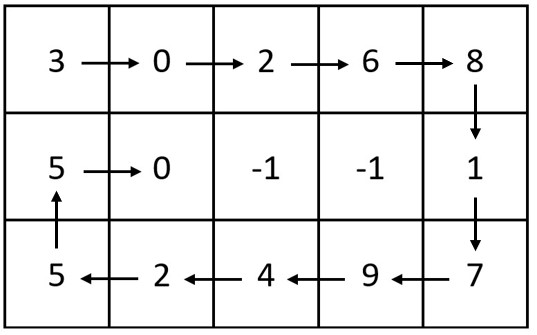You are given two integers m and n, which represent the dimensions of a matrix.
You are also given the head of a linked list of integers.
Generate an m x n matrix that contains the integers in the linked list presented in spiral order (clockwise), starting from the top-left of the matrix. If there are remaining empty spaces, fill them with -1.
Return the generated matrix.
Example 1:
Input: m = 3, n = 5, head = [3,0,2,6,8,1,7,9,4,2,5,5,0] Output: [[3,0,2,6,8],[5,0,-1,-1,1],[5,2,4,9,7]] Explanation: The diagram above shows how the values are printed in the matrix. Note that the remaining spaces in the matrix are filled with -1.
Example 2:
Input: m = 1, n = 4, head = [0,1,2] Output: [[0,1,2,-1]] Explanation: The diagram above shows how the values are printed from left to right in the matrix. The last space in the matrix is set to -1.
Constraints:
1 <= m, n <= 1051 <= m * n <= 105- The number of nodes in the list is in the range
[1, m * n]. 0 <= Node.val <= 1000
Related Topics:
Array, Linked List, Matrix, Simulation
Similar Questions:
Hints:
- First, generate an m x n matrix filled with -1s.
- Navigate within the matrix at (i, j) with the help of a direction vector ⟨di, dj⟩. At (i, j), you need to decide if you can keep going in the current direction.
- If you cannot keep going, rotate the direction vector clockwise by 90 degrees.
// OJ: https://leetcode.com/problems/spiral-matrix-iv
// Author: github.com/lzl124631x
// Time: O(MN)
// Space: O(1)
class Solution {
public:
vector<vector<int>> spiralMatrix(int m, int n, ListNode* head) {
vector<vector<int>> ans(m, vector<int>(n, -1));
int x = 0, y = 0, dirs[4][2] = {{0,1},{1,0},{0,-1},{-1,0}}, dir = 0;
while (head) {
ans[x][y] = head->val;
head = head->next;
int a = x + dirs[dir][0], b = y + dirs[dir][1];
if (a < 0 || a >= m || b < 0 || b >= n || ans[a][b] != -1) dir = (dir + 1) % 4;
x += dirs[dir][0], y += dirs[dir][1];
}
return ans;
}
};
